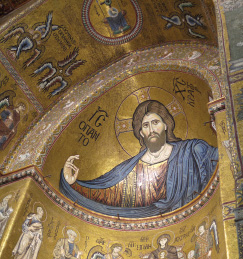![]()
MONREALE is only eight kilometres from Palermo. The modern road rises to the spur – 310 metres above sea level – on which the town stands, skirting the processional route laid out in 1762. It was at Monreale that in 1174 King William II founded the great monastery of Santa Maria Nuova, which became in turn a royal palace and the archiepiscopal seat. The king’s motive was to challenge the pretensions of the then Archbishop of Palermo – a neat solution by comparison with the murder of Saint Thomas à Becket by minions of the contemporary English monarch. And the riches of William II’s realm were liberally lavished. By 1189 the building was effectively finished; it is the consummate achievement of the Normans in Sicily.

Cathedral: apse mosaic, Pantocrator, late 12th century.
The façade is flanked by towers and partly masked by a late portico, which protects the wonderful portal with its bronze doors by Bonanno Pisano – the deviser of the Leaning Tower. The lateral (north-west) façade boasts equally fine bronze doors of 1179 by Barisano da Trani, and it is here that the tourist enters. The interior glows. Even on an overcast day, light is reflected from the glittering mosaics. A devastating fire of 1811 necessitated a long programme of restoration, but happily the apse mosaics were not significantly affected. The great Pantocrator dominates the long cycles of scenes from the Old and New Testaments. The scale of the project meant that, as for the doors, craftsmen had to be attracted from outside Sicily – from Venice and Byzantium. For uncouth adventurers as the Normans had so recently been, they had an instinctive respect for the artistic tastes of more established rulers.
The cloister, south of the cathedral, is one of the most beautiful complexes of its date in Europe. The ogival arches of the loggia rest on 228 double columns, variously decorated with mosaics and arabesques. The carved capitals of these are wonderfully inventive. On one, King William II himself is shown, offering his cathedral to the Virgin; there are biblical narratives and scenes of rural life, Norman knights and peasants, as well as a few animals and stylized plants. At the south-west corner is a fountain. This takes the form of the trunk of a palm and is enclosed within a square loggia, a wonderfully exotic touch that speaks perhaps of Cairo or Andalusia.
Cathedral: fountain in the cloister, late 12th century.